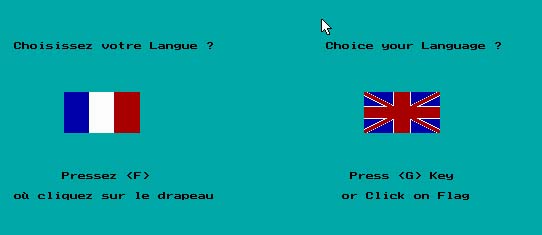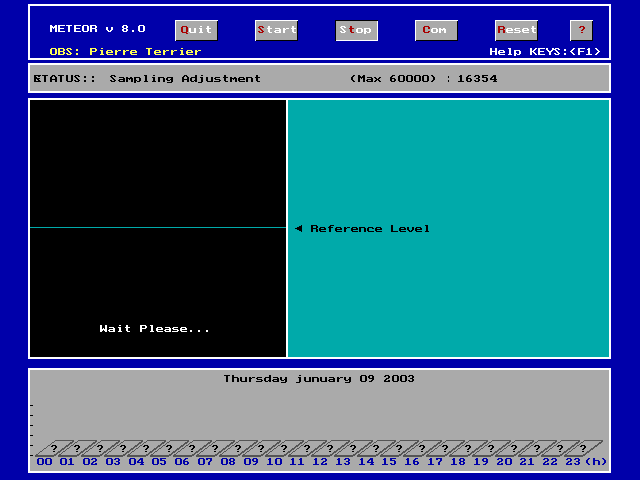
Documentation of Meteor v 8.0 |
|
WARNING ! |
|
Preamble |
The Meteor software functions correctly only if your radio installation is stable and can detect meteor echoes effectively. Concerning the materials necessary see the technical pages. Dave Swan (U.K)
created a protocol to the test the stability of your radio
installation. I strongly recommend you read it to assure that only
a received signal from an echo is counted. |
Sommaire |
|


At end of fill click on Save or press <Alt>+ <S>.




At the bottom of the screen the day count of the meteors appear as 3D bars.

2 echoes in time delay = only 1 count |
Here 1 "classic" echoe |
|
|

STA files (Statistic) A file of this type is created automatically every day. Its name indicates the date (DDMMYYYY.STA), ex: 12082002.STA = 12 August 2002. It is a simple DOS text file readable with Notepad, etc. The first column indicates the hour in universal time (UT), the semi-colon serves as the separator for the following column, which indicates the number of echoes counted in hourly ex: 0;25 = 25 echoes between 0h and 0h59mn59s.
The STA files are fundamental data, so it is prudent to save them in case of a system reset. They also allow Meteor v 8.0 to create the monthly report for your observations for the RMOB (Radio Meteor Observing Bulletin). This bulletin is a text file that will permit you to distribute and to compare your observations with the other observers around the world via the Internet. See http://www.rmob.org
Meteor creates this RMOB file automatically. The name of this file corresponds to the month e.g : RMOB012002.TXT = RMOB of January 2002. Its organization is simple and easy to understand, if you look at it with a text editor such as Microsoft's WordPad or Notepad. You can use this file to visualize your data as a graphic image with Colorgramme On Line on http://www.rmob.org
DAT Files (Data). This text file store all datas on length and numbers of echoes with a time resolution of 1 minute. Meteor create one of this file by day, and the name it is same of STA files, but it is stored in DAT subdirectory. The separator is ";" (semicolon). The first column indicates the hour, the second the length of echoes in seconds, the third the length of echoes in pixels, the fourth the number of echoes during this minute, the fifth is the average of the flux while this minute. The saving of this datas is automated every 10 minutes. I f you stop the process and restart later before a same day "*;*;*;*;*" is included in the file to indicate this cut. This files is used by Meteor to build the RMOB file of lengt of the echoes and used also by Colorgramme WMeteor for analysis. It is easy to edit with Microsoft® Excel.
RAW Files (Files of data) If you check the RAW files in Meteor, you see it creates a file. Its name indicates the date and the hour, created automatically each hour, ex.: 18110206.RAW = 18 November 2002 slice 06 h UT. These files are encoded with 8 bits and are readable for analysis using Colorgramme WMeteor. See analysis page. Attention: the RAW file stores and measures all that appears on screen and creates a 16 Kb. (Kilobytes) file each hour that may quickly fill up your PC's hard drive. This files is readable only with Colorgramme WMeteor.
NDX Files (index Files) This index files exist only if you check the RAW files in Meteor. These files is necessary to display the time and length of echoes with Colorgramme WMeteor.
How to access at my files under DOS ?
The access to files of data under Windows®
is easy with windows explorer.
It is less obvious under DOS when one doesn't know command of this OS.
Here is a small summary of commands useful
for beginner under DOS ;-)
In follows, to explain, DOS commands
is writings between hooks.
To go in a directory DOS command
is [CD]+ directory name.
Example if you have prompt C:>
Write [CD METEORV8]
<enter> now you are in METEORV8 directory.
To go in subdir DATAS write [CD
DATAS] <enter> now you are
in this subdir.
To go in subdir RMOB, write [CD
RMOB] <enter> now you are
in RMOB subdir.
At his ce moment if you want to copy RMOB file in this directory to A: drive
(floppy)
write [COPY *.* A:] <enter>
The RMOB files is copied from METEORV8/DATA/RMOB to A: floppy disk.
Same process to copy DAT or STA files while replacing RMOB by DAT or STA.
Here is a screen shoot of this process.

To exit the directory or subdir and come back to C: write [CD\]
<enter>
To "go down" from one directory toward another (example STA) toward
DATAS write [CD..] <enter>
You can go more quickly to copy your files from [C:\] while using below process.
From C:> prompt.
Write [COPY C:\METEORV8\RMOB\*.* A: <enter>
Replace RMOB by DAT to copy DAT files.
Now you can verify the presence of your files on A: floppy disk by DOS command [DIR A:]<enter>
To what do my data be useful ?
If you send your RMOB files each
end of month to Christian Steyaert, these
will be published in Radio Meteor Observing Bulletin.
These data accessible on the site http://www.rmob.org
are consulted and used by the astronomers specialist of forecastings models
of meteors shower.
The PERMANENT data collection is extremely useful because it also permits to visualize the density of meteors according to the period of the year, as well as meteor background known very pain. To this topic see the software RMOB Survey on http://www.rmob.org
Pierre Terrier 2002
Meteor Ver. 8 calibration System par Dave Swan (UK) |
|
How to build ? Take a 50/75 ohm plug and solder one end of a 50/75 ohm resistor to the centre pin and the other end to the outer case. |
1. Connect up the system and set the receiver to the frequency in use. Terminate the receiver antenna input in its Characteristic Impedance, this is usually 50 ohm for professional or scanning receivers and 75ohms for Band 2 FM stereo receivers. Use only carbon resistors not wire wound. Reset the system and adjust the Threshold controls above and below the displayed Noise level so that the system is not triggered into producing a count. If the system is triggered adjust the necessary threshold to prevent this. When the system is running with no triggering observe for at least 30 minutes to confirm no random triggering of the system. If random triggering persists the probable cause is man-made noise getting through the power lines or computer hash usually the monitor, fit an appropriate filter. If an RF Signal Generator is available, see Annex A. Continuing from 3. Observe the displayed noise level and remove the terminating resistor and refit the antenna, if the antenna is a good match and there is no man-made noise present, you should see no major increase in noise. Reset the system, and you are ready to start observing. Changing any of the system components will require system Reset. This set-up is to ensure that the system itself is not generating false counts! Annex A: At this point the system sensitivity can be measured. If any problems occur with this procedure contact: daveswan@dorsetpubs.com |
|
|
|
From Meteor v 6.0 my programming work is helped by some users observers. They test versions and suggest improvements. <?> button display the contributors without stop the processing. |
|